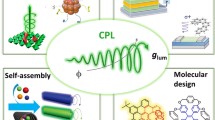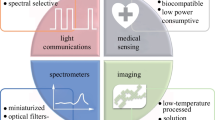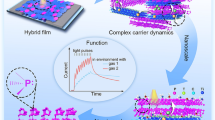Abstract
The charge transport across a molecular junction formed by sandwiching molecules between two electrodes in testbed architectures depends not only on the work function of the metal electrodes and energy gap of the molecules but also on the efficacy of the molecule–electrode electronic coupling. Insights into such molecule–electrode coupling would help to understand the relation between the coupling strength and electron transport processes. With this aim, the optoelectronic modulation across bacteriorhodopsin-based molecular junctions has been studied using experimental current–voltage traces obtained by conducting-probe atomic force microscopy under various illuminations. The energy barrier \( \left( {\varepsilon_{0} } \right) \), molecule–electrode coupling (Γg), and other transport parameters were determined utilizing the Landauer model with a single-Lorentzian transmission function, transition voltage spectroscopy, and the law of corresponding states in the universal tunneling model approach. The findings reveal that the optoelectronic modulation of bacteriorhodopsin molecular junctions originate from alteration of the molecule–electrode coupling, which could originate from modulation of electronic states and the electrostatic environment of retinal chromophores made of the protein under dark and green or green–blue illumination conditions.
Similar content being viewed by others
References
S.S. Panda, H.E. Katz, and J.D. Tovar, Chem. Soc. Rev. 47, 3640 (2018).
J.J. Davis, D.A. Morgan, C.L. Wrathmell, D.N. Axford, J. Zhao, and N. Wang, J. Mater. Chem. 15, 2160 (2005).
I. Ron, L. Sepunaru, S. Itzhakov, T. Belenkova, N. Friedman, I. Pecht, M. Sheves, and D. Cahen, J. Am. Chem. Soc. 132, 4131 (2010).
O. Berthoumieu, A.V. Patil, W. Xi, L. Aslimovska, J.J. Davis, and A. Watts, Nano Lett. 12, 899 (2012).
A.V. Patil, T. Premaruban, O. Berthoumieu, A. Watts, and J.J. Davis, J. Phys. Chem. B 116, 683 (2012).
Y.D. Jin, N. Friedman, M. Sheves, and D. Cahen, Adv. Funct. Mater. 17, 1417 (2007).
A.V. Patil, T. Premaraban, O. Berthoumieu, A. Watts, and J.J. Davis, Chem. Eur. J. 18, 5632 (2012).
T. Ando, Mesoscopic Physics and Electronics, ed. T. Ando, Y. Arakawa, K. Furuya, S. Komiyama, and H. Nakashima (Berlin: Springer, 1998), pp. 11–14.
A. Vilan, J. Phys. Chem. C 111, 4431 (2007).
A. Vilan, D. Cahen, and E. Kraisler, ACS Nano 7, 695 (2013).
M. Ben-Nun, J. Quenneville, and T.J. Martínez, J. Phys. Chem. A 104, 5161 (2000).
C. Punwong, T.J. Martínez, and S. Hannongbua, Chem. Phys. Lett. 610–611, 213 (2014).
E. Nango, et’al., Science 354, 1552 (2016).
J. Allen, F1000 Fac. Rev. Res. 8, 211 (2019).
L. Sepunaru, N. Friedman, I. Pecht, M. Sheves, and D. Cahen, J. Am. Chem. Soc. 134, 4169 (2012).
Acknowledgments
K.R. acknowledges financial support from the Department of Physics, and SRM University research program for her doctoral fellowship. S.M. acknowledges SERB-DST, Govt. of India for Early Career Research Award Grants (ECR/2017/001937), Molecule–Electrode Electronic Coupling Modulates Optoelectronics of (Bio)Molecular Junctions and SRM University research funding for financial support. We acknowledge support from the Chemical Research Support group of WIS, Israel for experimental facilities and scientific discussions.
Author information
Authors and Affiliations
Corresponding author
Additional information
Publisher’s Note
Springer Nature remains neutral with regard to jurisdictional claims in published maps and institutional affiliations.
Electronic supplementary material
Below is the link to the electronic supplementary material.
Rights and permissions
About this article
Cite this article
Ramya, K., Mukhopadhyay, S. Molecule–Electrode Electronic Coupling Modulates Optoelectronics of (Bio)Molecular Junctions. J. Electron. Mater. 50, 1573–1580 (2021). https://doi.org/10.1007/s11664-020-08263-y
Received:
Accepted:
Published:
Issue Date:
DOI: https://doi.org/10.1007/s11664-020-08263-y




